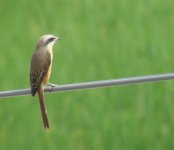MKinHK
Mike Kilburn

Mark Bruce said:Mike, you're seeing a lot more Dollarbirds than us.
The northern Dollarbirds (mostly race calonyx) seem to move down into southern China for winter with very few Dollarbirds moving out into the Taiwan Strait. I'm not sure if any of the birds from SE Xizang (race cyanicollis) are heading to the Philippines (where race cyanicollis is resident) and these possibly are the handful of birds we are seeing passing through Taiwan.
I'm spending the weekend on two Taiwan Endemic Species Research Institute (TESRI) field stations in the central mountains and will ask if anyone knows anything about the Dollarbirds passing through Taiwan.
The Blue-tailed Bee-eater is another strange one. Spends the summer on the Taiwan controlled island of Kinmen in the Taiwan Strait. Reasonably common on the Fujian coast and resident in the Philippines but not a single record from Taiwan proper, in spite their presence in the Taiwan Strait during typhoon season.
Hi Mark The only reference I can find to Cyanicollis Dollarbirds is in (the accursed!) Mackinnon. It seems like an extraordinary migration route - I would be very interested to find out more! None in my valley yet - I think the wind (NE monsoon) is so favourable that they are simply not stopping.
No Blue-Tailed Bee-eaters yet either - I suspect for the same reason , although they should be picked up early mornings as they are diurnal migrants.
The patch today offered more of the same:
Eastern-crowned Warbler - 1
Arctic Warbler - 2
Pale-legged/Sakhalin Leaf Warbler - 3 heard
Asian Paradise Flycatcher - 1
This bird gave brilliant close views and allowed me to confirm that I had erroneously claimed it as Japanese Para a couple of days ago - it wasn't nearly dark enough.
The "new" residents also scored today - singing Pygmy Wren Babbler and Lesser Shortwings but best of all were the "Tailorbird Wars" towards the top of my route.
A manky-looking Mountain Tailorbird without a tail, seemed to be getting close attention, but not aggression, from a glorious-looking adult. I have never seen one so showy - coming really close, throwing back its head, puffing out its throat and singing for all it was worth. A Common Tailorbird called and then appeared and the MT semed to get even more excited - no fighting as such, but it seemed that some sort of turf war of the tinys was going on with all three birds bounding about in the open with no regard to me whatsoever!
I was going to go al the way to the top falls, but discovered at first hand how little fun it is to get poked in the eye with a sharp stick when trying to free a tree from creepers. Not fatal, but definitely not recommended!
The weaqther man says there is going to be some rain in the front over the next few days - so here's hoping for some more goodies - an unusual autumn Spoon-billed Sandpiper was at Mai Po yesterday.




